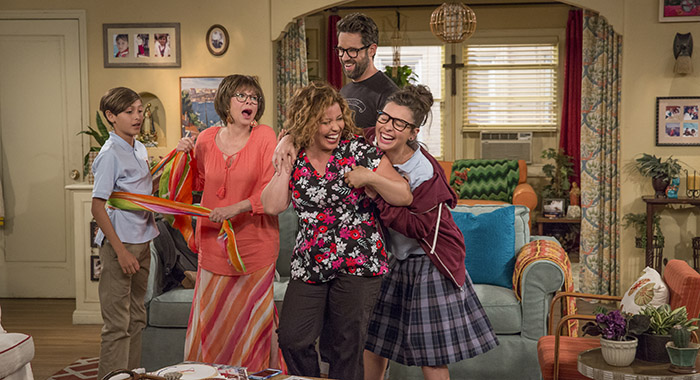
This is it, this is it, this is life, the one you get, so go and have a ball!
Those old enough may recall the 1970s sitcom theme song refrain. But imagine Gloria Estefan singing those words to a hot salsa beat. Add in a primarily Latino cast and some topicality relevant in the Donald Trump era, and you’ve got the modern version of Norman Lear’s classic One Day at a Time, coming to Netflix in January.
Here’s what you need to know about the series before you binge all 13 episodes on January 6, in the stars’ own words.
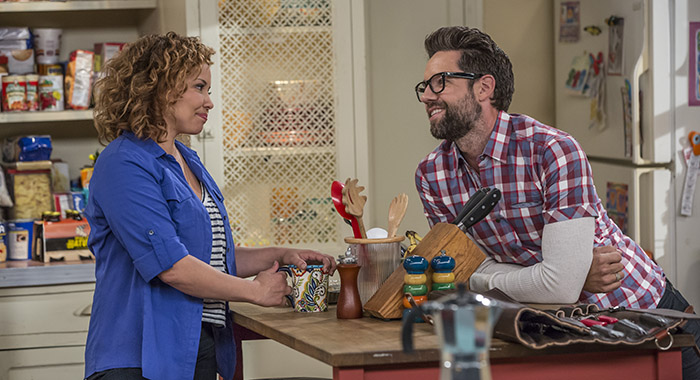
When you think of bygone series getting a second life, you may think you’re in for a rehash of characters and plotlines from days of old: Full House’s D.J. Tanner, with a few more lines on her face, struggling with the loss of a spouse; The X-Files grizzled veteran agents Mulder and Scully trying to figure out, once and for all, if the truth really is out there.
One Day at a Time is not like those shows.
“It’s not a reboot,” co-showrunner Gloria Calderón Kellett tells Rotten Tomatoes.
Lear’s producing partner Brent Miller had the idea of “reimagining” One Day at a Time with a predominately Latino cast, and they brought Kellett on board to tell them about her life.
“My mom was a working mom, and I was with my grandmother when she was working — when [my parents] were both working,” she says. “So that’s just what I know. And so when I pitched that to Norman, he was like, ‘I love that, I love that!’”
That “reimagining” of the late ’70s–early ’80s series includes none of the same plots or characters — with the loose exception of Schneider.
Today’s butt-insky neighbor isn’t the nosy building superintendent, but rather the equally clueless — and equally loveable — wealthy young owner of the condo complex.
“It’s the same name, and the construct of the character is the same in the sense that the original Schneider and the current Schneider are guys who live in the building,” Todd Grinnell, who plays Schneider in the Netflix series, tells Rotten Tomatoes.
“They’re pretty lonely guys who find a kinship with this family and glom onto them,” Grinnell says. “They become sort of this adopted uncle–type figure to the family, so that structure is there.”
But the writers knew they shouldn’t try to replicate the singular character that the old Schneider was.
“We knew we had to depart from the original one, because Pat Harrington Jr. is a brilliant, brilliant actor,” Grinnell says. “He’s an icon, and he made that character iconic. Coming into this we were all like, ‘We can’t do that. We just can’t try to replicate that, so what are we going to do?’”
What results is a character all his own — with a hint of the familiar to keep things light.
“I think the two Schneiders do share [an] inflated sense of self-importance,” Grinnell says with a laugh.
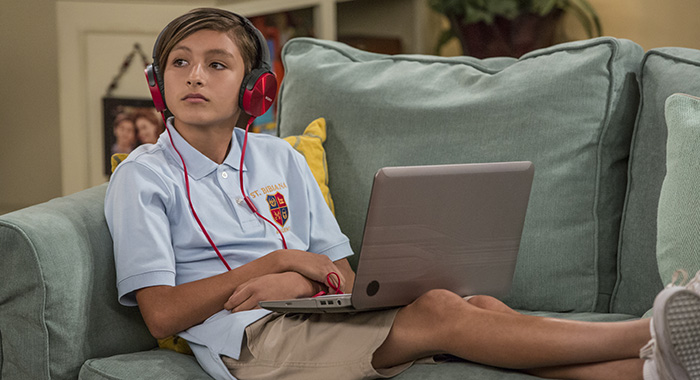
If the characters aren’t based on the ones played by Bonnie Franklin, Mackenzie Phillips, and Valerie Bertinelli, just where did they come from?
“Our families merged in the show, in terms of bringing stuff to the characters. The writers and their experiences,” co-showrunner Mike Royce tells us.
Kellett says that while she is happily married to her high school sweetheart, Lear prompted her to imagine what a divorce might look like in her family to gain inspiration for the series protagonist, separated Army veteran Penelope Alvarez (Justina Machado). Her first thought was that her parents would be quite involved.
“He was like, ‘Talk to me about what would happen, if you got divorced. What would that look like for you,’” Kellett tells us. “I just told him about my parents, [they] were a huge part of my life — very Latino.”
“My mom kinda looks like Rita [Moreno] — I mean, they’re two little boob popsicles!” Kellett laughs. “You know, little skinny, adorable, powerhouse women. And so, it was, just that was organic to me because I had so much to mine from my own life in that capacity. So that’s how the mother character came about.”
Royce says his own children are the same ages as the kids on the show — Elena, 14, and Alex, 12 — so he takes inspiration from his own household — sometimes to the chagrin of his family.
“They’re old enough where they’re sort of weirdly flattered, but also scared,” Royce says.
“Of course it changes; once it gets in the [writers’] room it becomes a different thing,” he adds. “But then when you see it played out, if there are similarities that are still there, and you’re sort of thinking about your own kids, and then you’re seeing it being acted out, and then you start weeping in front of the monitors, and everyone wants to take you away because you’re crazy!”
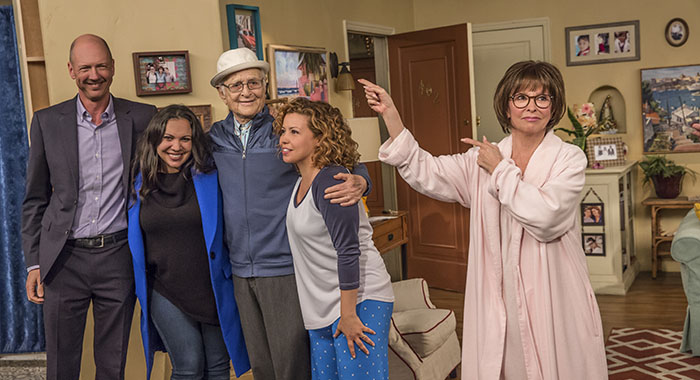
This is definitely not a Norman Lear knock-off. The legend himself is one of the series’ executive producers, and the show has all the silliness and seriousness of a Lear classic.
As most of his sitcoms did, this version of One Day packs in as many laughs as it does gut punches, tackling 21st century social issues with the deft mix of humor and gravitas that became Lear’s signature.
“It is unusual in the sense that — and that’s so typically Norman Lear — that every single episode has an issue,” Moreno told us. “And more often than not, you end up with tears in your eyes, because things are so touching, and yet, it’s a hilarious show! That’s such a wonderful thing about the show: that it’s funny and serious and funny and serious.”
Royce said he understands the weight of carrying the Lear stamp on a show he’s responsible for.
“I just hope — because Norman’s shows were so important when they were in their heyday, that we took the stuff that he, the tools that he used: the kind of play-like structure, the emotion you can bring to a play that’s really, really big but really deeply felt — that people see that it can be a show that they relate to and resonate with, even though it’s this old school thing. That it has a really good purpose,” Royce tells us.
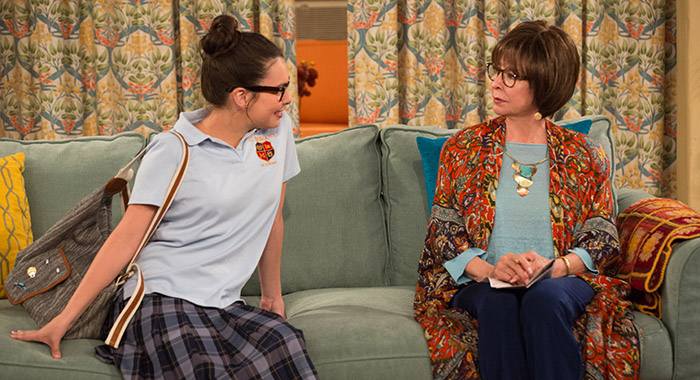
A Latin version of One Day at a Time doesn’t just “sound nice.” It doesn’t just pay lip service to diversity in Hollywood.
Behind the camera, producers say, the writers’ room is half Hispanic, including scribes of Mexican, El Salvadorian, Puerto Rican, and Cuban origin. There are LGBTQ writers in the room to speak from a position of authority on relevant storylines, and of course, plenty of women in the room too.
“It’s not 12 white guys in a room going, ‘Uhh, I think it would be…’ You know? ‘I think she’d say…’” Royce explains. “It really comes from everyone’s specific experience, but to get that specific experience, you have to get those people in the room.”
But it’s the types of people we see on screen that are of paramount importance, according to the cast and crew.
“[It] is important to us, very important to me, very important to Gloria, and all of us, that we are represented the way we want to be seen,” Machado says.
“Ain’t nobody playin’ the best friend that’s a wiseass,” she adds, putting on with disdain the stereotypical affectations we’ve heard in a thousand cliché roles before.
Kellett faced that sort of typecasting as an actor before deciding to write her own life script.
“I actually came out [to L.A.] to be an actor originally, and every audition I went out on was to be a gangbanger’s girlfriend or a gangbanger’s sister,” Kellett says. “And I was like, ‘Really? There’s not like a teacher or a lawyer?’ And I felt, Well, if people aren’t writing that, I’ll write it. And I started writing material for myself.”
Moreno says that the military angle takes the show beyond the obvious and opens up a whole new avenue of on-screen representation.
“I think the fact that they made the protagonist, the leading protagonist, a war veteran has opened so many stories up that we could never have done otherwise,” she tells us.
Even the youngest generation of Alvarez women is atypical, and that’s refreshing to see on TV, says the actress who portrays Elena, Isabella Gomez.
“It’s so empowering to have a teen daughter that’s different, that’s more into facts than beauty, but can also see how beauty is an asset,” Gomez says. “I think she’s super deep and super layered, and I love her.”
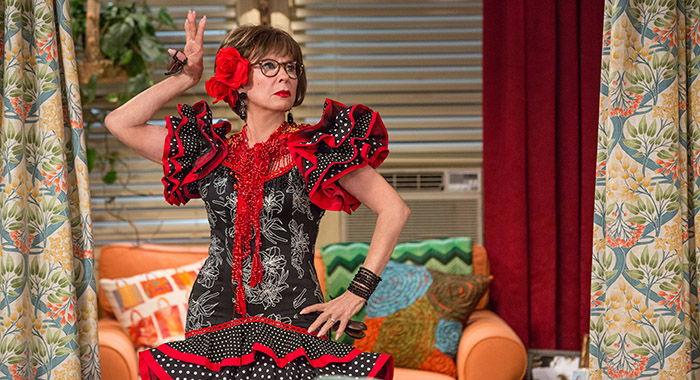
If you’re worried you may wind up struggling to relate to the characters in One Day at a Time, don’t be.
“The show is universal because we’re human beings, and we’re not doing a show about Latino people,” Machado says. “We’re doing a show about a family, and we just happen to be a Latino cast.”
“It’s about family, essentially, and all that that implies,” Moreno adds. “But what gives it that extra kick is the Hispanic salsa that we inject into it, our Hispanic selves.”
That “extra kick” includes a fair amount of Spanglish, a rich joke area drawn from Kellett’s own experience as “La Gringa” in her family for allowing Spanish fluency to fade over the generations.
But the writers are careful not to go over the top with the Español, lest they alienate those of us whose Spanish-English dictionaries may be a little dusty.
“You’re not leaving out your non-Spanish speaking audience at all. You’re careful about speaking too much Spanish,” Moreno says. “You’re careful about my character who’s so big — you don’t want to do Desi Arnaz.”
Still, there are a couple of entry points into the series for non-Latinos who may need a character to identify with at first. Stephen Tobolowsky plays Dr. Berkowitz, Penelope’s boss at a small medical practice. He also serves as an everyman, who doesn’t quite get all of the Cuban-American customs, but approaches the Alvarez family with love, and relishes the opportunity to understand more as he’s welcomed into the clan.
“If you take a look at this story as a stranger in a strange land, I present a doorway for people who aren’t familiar with the Latin or Cuban culture,” Tobolowsky says. “We know what this older, white doctor is. What we know is that I’m probably good at what I do, that like Penelope… my family’s broken, except differently.
“I look to Penelope’s character because her family loves her,” he adds. “Even though I am her superior in the workplace — I’m the doctor, she is my nurse — she is my superior in the life space.”
Schneider fills the same role as a potential doorway for quinoa-loving hipsters who think they’re hip to minorities’ struggles, but really have no idea.
“He becomes on a large level of the show a symbol of gentrification and white privilege, in contrast to this Cuban-American family who’s going through general struggles that Schneider is maybe not aware of or has no relation to,” Grinnell tells us. “Even though he’s a liberal, progressive person in his mind, he’s never had to deal with this stuff.”
Moreno sees this new version of One Day at a Time as a new standard-bearer for shows with a Latino cast.
“I think this show has — no, I don’t ‘think,’ I know this show has set a new standard for Latino-type shows, because it has a huge, gorgeous balance between what’s going to interest people who don’t speak Spanish, who are not Latino,” she says.
“You have to keep that in mind, and that’s not an easy balance to maintain, by the way,” she adds. “It’s too easy to do clichés, stereotypes, and also to speak too much of your native language — the kind of stuff that leaves people out. And they just absolutely put together a marvelous balance for this show.”
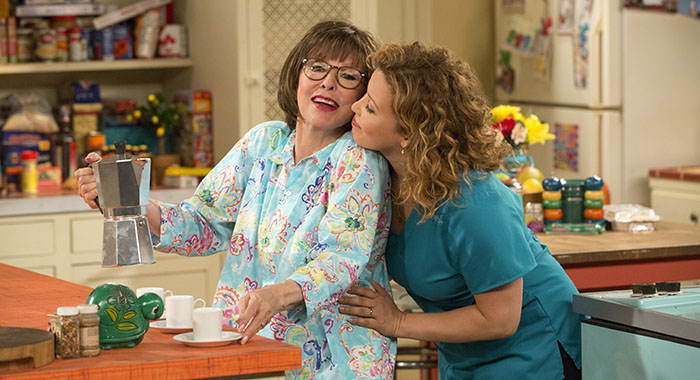
About yourself, about your neighbors, or about the world — if you watch it right, you’ll learn something from this version of One Day at a Time.
Part of the Norman Lear brand is a topicality that addresses hot-button social issues in a manner organic to the story, making you think about life without being too heavy-handed about it.
“This is a woman that’s hardworking, and a badass, and served her country, and is doing her best to raise her kids — and they happen to be Cuban,” Kellett says, describing Penelope.
“It’s incredibly meaningful to talk about these things, because I think, especially with this election, what it’s told me, is that there’s this strange fear of Latinos right now in this country,” she adds. “And if I can invite people into my living room and meet my family, we could change that.”
It’s that universality of experience that the cast and crew of One Day found to be one of the most important lessons from the show.
“We all deal with the same stuff, every single one of us; we just maybe might deal with it a little bit different because of culture,” Machado says.
“There’s a whole thing, an episode, about religion. Your mom wants you to go to church,” she laughs. “That’s universal, you know what I mean? Immigration, that’s universal. Sexism, that’s universal. So it’s important for us — oh my God, it’s so important that we’re not put in a box.”
Machado’s character is a veteran Army nurse who served in Afghanistan — and was wounded in action. Some of her struggles throughout the first season include dealing with post-traumatic stress disorder (PTSD) and trying to get help from the Department of Veterans Affairs.
To portray Penelope right, Machado had to learn a few things too.
“I did feel pressure about [telling the veteran story], until I met somebody — Priscilla — who came in and spoke with us, and then I went and had a two-hour lunch with her,” she says. “Then, I kind of saw that we weren’t very different.”
In fact, that’s the message everyone involved hopes viewers take away from watching One Day at a Time: a sense of unity through storytelling, hopefulness about our potential as a country to see eye to eye.
“I’m looking at a beautiful black face [your writer], and she’s looking at this older white one, and what we have in common as human beings so, by far transcends [differences] and suggests we want to know one another better,” Lear says. “That’s what I think is the glory and the heart of seeing five people from another culture, expressing that culture in their American circumstance. It’s wonderful.”
One Day at a Time premieres on Netflix on January 6